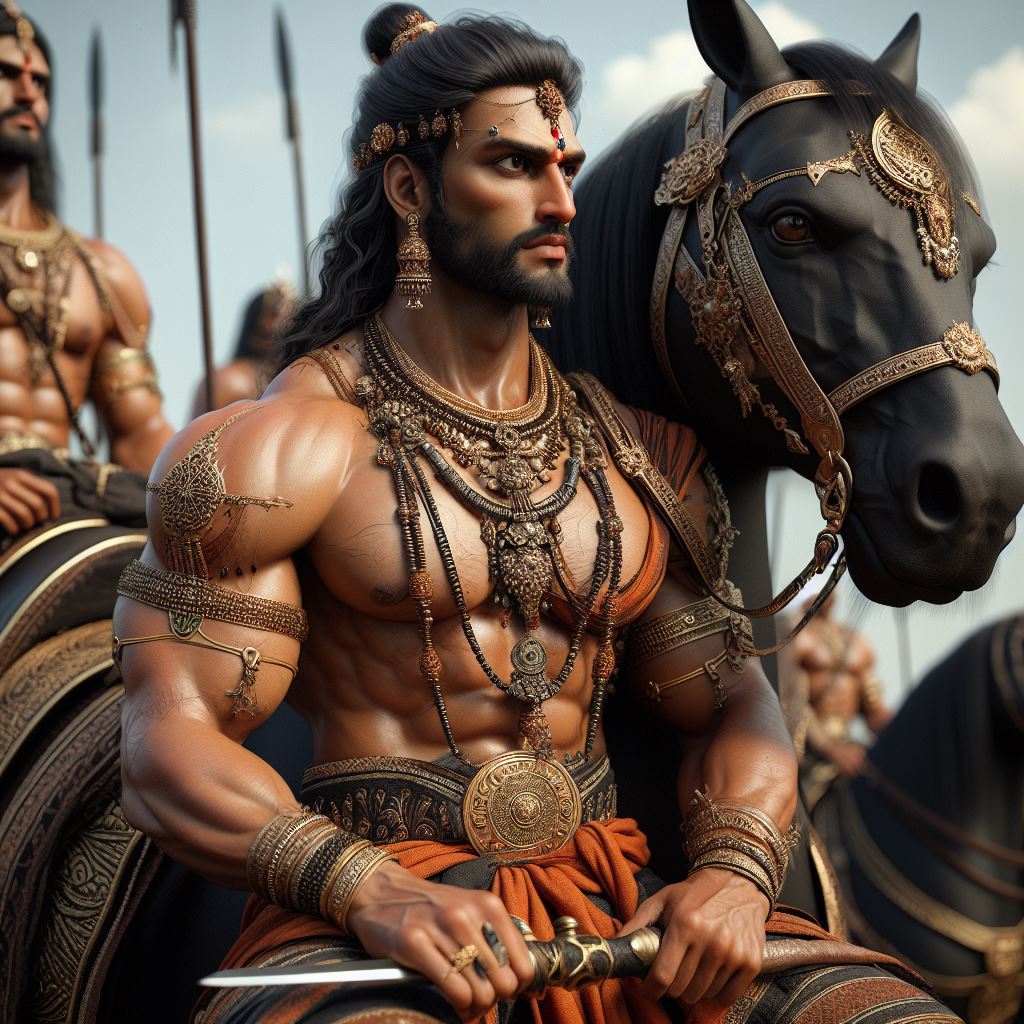Sanatan Articles
Satyaagrah
Written on
Satyaagrah
Written on
Satyaagrah
Written on
Satyaagrah
Written on
Satyaagrah
Written on
JOIN SATYAAGRAH SOCIAL MEDIA
"Love Jihad in 1565": Sulaiman Karrani orchestrated a sinister plot, ensnaring Kalapahad, a once valiant & staunch Hindu General unbeaten in battle, by using his daughter. The tragic tale unfolds as power, betrayal, and conversion reshape Orissa's history

In the 16th century, Rajiv Lochan Ray, renowned as Kalapahad, stood as the formidable army general under King Gajapati Mukundadeva of Kalinga (Orissa). The very name 'Kalapahad,' signifying 'Black Hill,' mirrored the imposing physicality and stature of this military commander. Despite his Hindu roots, historical accounts from both Orissa and the Mughal records portray him as a Muslim General of the Gaur Sultanate. His legacy bears the weight of the Konark Sun temple and Jagannath temple assaults, prompting a profound inquiry into how the once indomitable Hindu general embraced Islam and, as a converted Muslim, turned against his own temples.
How did Rajiv Lochan Ray, the strongest pillar of the Orissa army, transition into a Muslim general, orchestrating the destruction of revered temples? This enigma unfolds against the backdrop of a love jihad trap laid by Sulaiman Karrani, the Pathan Sultan of Gaur in Bengal. In a treacherous act, Karrani converted Rajiv Lochan Ray, now also known as Kalachand Roy, exploiting his newfound allegiance to lead the very army he once commanded under the banner of Orissa.
Born a Brahmin, Kalapahad's journey was marked by an ascent from the confines of his birth to become the most trusted general of Orissa. His martial skills and valor elevated him to a position of power, where he stood undefeated in every battle fought.
The temple attacks, attributed to Kalapahad, were not mere acts of warfare but a sinister consequence of love jihad's manipulation by Sulaiman Karrani. The story of Kalapahad encapsulates the tragic transformation from a loyal Hindu warrior to an unwitting instrument of temple destruction.
This was a trap of love jihad by Sulaiman Karrani, the Pathan Sultan of Gaur of Bengal. He treacherously converted him and used him to lead his army! Though he was a Hindu, as a converted Muslim why did he destroy temples?
As we delve into the mysteries surrounding Kalapahad, the narrative unfolds with the gravity befitting this historical tragedy. The echoes of betrayal, conversion, and temple destruction form the backdrop of a story that demands answers to questions as old as time.
|
In the same era, Rudranarayan, the formidable ruler of the Bhurishrestha kingdom, encompassing the present-day Howrah and Hooghly districts of Bengal, held sway. His dominion extended further to include the southern expanse of Burdwan, East Midnapore, and significant portions of West Midnapore. Recognizing the need for robust defense, Rudranarayan bolstered his empire by fortifying the navy, deploying a formidable naval force along the banks of the Damodar and the Ron rivers within his domain.
Amidst this period, the Mughal Empire, led by the formidable Akbar in Delhi, exerted its influence, and Islamic rulers in neighboring provinces strengthened their positions. The looming specter of Islamic invaders cast a perpetual shadow, creating an atmosphere of uncertainty. In a strategic move, Rudranarayan, in alliance with the king of Kalinga, aimed to counter the ascending Pathan Sultanate of Gaur, then under the rule of Sulaiman Karrani.
With the Pathan Sultanate of Gaur, headed by Sulaiman Karrani, gaining prominence, Rudranarayan perceived the need to thwart potential threats. In collaboration with the king of Kalinga, a united front was forged to counter the rising influence of the Gaur kingdom. The geopolitical landscape was shifting, and alliances became paramount in navigating the delicate balance of power.
In the annals of 1563, Sulaiman Karrani ascended to the Sultanate of Gaur after succeeding his brother Taj Khan. Taj Khan, once an employee under Sher Shah Suri, rose against his erstwhile master, instigating a rebellion that laid the foundation for the Karrani Sultanate in the heart of Bengal. While the Karrani Sultans operated under the nominal sovereignty of the Mughals, their autonomy was circumscribed — they were unable to mint their own coins and were obligated to regularly pay tributes to the Mughal Empire.
|
Sulaiman Karrani, however, harbored ambitions that stretched far beyond the limitations imposed by the Mughals. His aspiration was twofold: to expand his empire by subjugating neighboring realms like Bihar, Bengal, and Orissa, and to boldly wage war against the Mughals. To actualize this audacious vision, Karrani sought strategic alliances with rulers already under Mughal dominion. The echoes of this ambition reverberated beyond Gaur as many Afghans hailing from Delhi, Oudh, Gwalior, and Allahabad united with Karrani, forming a robust coalition poised to challenge the formidable Mughal Empire.
In the intricate dance of politics, Rudranarayan, the stalwart ruler of the Bhurishrestha kingdom, embarked on a mission to shape his destiny. Recognizing the looming threat posed by Sulaiman Karrani's expansionist designs for the Pathan Sultanate, Rudranarayan orchestrated a strategic alliance with Gajapati Mukundadeva and neighboring rulers. The objective: to preemptively strike against Sulaiman Karrani before his grand plans could materialize. Also known as Mukunda Harichandana, Mukundadeva ascended the throne of Orissa in 1559, a realm then referred to as Kalinga. The empire under Mukundadeva's rule extended its influence over parts of Orissa, Bengal, and Bihar.
Mukundadeva, believed to be of Chalukyan origin, had a compelling backstory. Formerly a minister under Raja Chakrapratap of Orissa's Bhoi dynasty, Mukundadeva seized power after rebelling against the Bhoi kingship. His ascent to the throne included a ruthless episode where he eliminated the last two Bhoi heirs. Kalapahad, his imposing and trusted general, stood by his side, resembling a mountain in both stature and loyalty.
While orchestrating these intricate political maneuvers, Mukundadeva found himself entangled in the webs of allegiance. In the year 1565, he accepted the suzerainty of Akbar, the Mughal Emperor. Akbar, foreseeing a potential revolt by the Karrani Sultan, sought the support of local rulers to quell this threat. Mukundadeva's acceptance of Akbar's suzerainty marked a pivotal moment in the unfolding drama. Akbar eagerly awaited Mukundadeva's move, knowing that the combined forces of Kalinga and Bhurishrestha were gearing up to confront Sulaiman Karrani.
|
The chessboard of war saw Kalapahad, the colossal general, elevated to the prestigious position of commander, leading the united forces of Bhurishrestha and Kalinga. The stage was set for a fierce confrontation, and in 1565, the battleground unfolded at Tribeni, situated in the Hoogly region of Bengal. Tribeni, a significant junction, marked the confluence of three mighty rivers – Yamuna, Ganga, and Saraswati, providing a symbolic backdrop to the impending clash of empires.
The battle that ensued was nothing short of legendary. The allied forces, under the indomitable leadership of Kalapahad, displayed unparalleled bravery, turning the tide decisively against Karrani. The forces of the Pathan Sultan were decimated, resembling scattered hay in the aftermath of the onslaught. The once invincible Karrani found his forces obliterated, and in the face of impending defeat, he fled the battlefield, leaving behind the echoes of a resounding victory.
Following this awe-inspiring triumph, Gajapati Mukundadeva, in a gesture of profound appreciation, bestowed upon Kalapahad the reins of administrative control over Saptagram. Nestled in Bengal near Hoogly, Saptagram held significance as a part of the Kalinga kingdom. The victory at Tribeni, a testament to Kalapahad's leadership, was eternally commemorated by Gajapati Mukundadeva. In homage to the triumph, a temple was erected at Tribeni on the banks of the Ganga, standing proudly at a ghat at Gajagiri.
In the wake of the ferocious battle at Tribeni, a delicate peace emerged through a signed treaty between the allied forces and Sulaiman Karrani. The dynamics, however, were intricate. Mukundadeva, backed by the formidable Akbar, stood as a force that Karrani deemed unworthy of aggression. Yet, Rudranarayan of the Bhurishrestha kingdom had not bowed to Akbar's suzerainty or forged any alliance. This opened a vulnerable flank for Karrani, who, sensing an opportunity, set his sights on Bhurishrestha.
But friendship held sway over strategic calculations. Rudranarayan and Mukundadeva shared a bond, ensuring that the Bengal kingdom had a stalwart defender in the form of Kalapahad. As long as the valiant Kalapahad commanded, Karrani's aspirations to conquer Rudranarayan remained a distant dream.
|
In a bid to reshape the power dynamics, Sulaiman Karrani hatched a cunning plan. Recognizing the pivotal role of Kalapahad, he aimed to sway the formidable commander to his side. Victory in this diplomatic endeavor would not only guarantee triumph over Rudranarayan but also over Mukundadeva and neighboring kings. More significantly, it could set the stage for a rebellion against the Mughals, allowing Karrani to carve out an empire of his own. The intricate dance of alliances and betrayals unfolded, with Karrani harboring grand visions of establishing a realm that defied both Mughal dominance and regional adversaries.
In a twist of fate, Kalapahad found himself entangled in the webs of diplomacy and love. Representing the Kalinga king, he ventured into Karrani's domain to negotiate the delicate intricacies of a peace treaty. Little did he know that the wheels of treachery were already set in motion. Karrani, seizing the opportunity, introduced Kalapahad to his enchanting daughter, Gulnaaz. This encounter, ostensibly diplomatic, evolved into a strategic move as Karrani surreptitiously wove a web of love around the unsuspecting Kalapahad. In the context of contemporary discourse, it eerily echoes the notion of "love jihad" that has persisted for centuries.
Gulnaaz, assigned the task of hosting Kalapahad at the Sultan's residence, embarked on a subtle campaign to captivate the Hindu Brahmin general. The ploy worked, and Kalapahad, renowned for his valor on the battlefield, found himself ensnared in the delicate threads of love. An elated Karrani, recognizing the potential of this alliance, fueled the flames, eagerly anticipating the union through matrimony. However, he harbored a condition that would alter the course of Kalapahad's destiny.
As the impending marriage loomed on the horizon, Karrani, with calculated precision, introduced a condition. To wed Gulnaaz, Kalapahad was required to convert to Islam. Initially hesitant, Kalapahad countered with a bold condition of his own – Gulnaaz should embrace Hinduism. The negotiation reached an impasse, and as a last resort, faced with limited options, Kalapahad reluctantly agreed to embrace Islam. The once resolute Hindu general, now poised on the precipice of conversion, navigated a tumultuous path driven by love, deception, and the inexorable forces of political intrigue.
In the labyrinth of political machinations, Kalapahad devised a calculated strategy. The Hindu general, anticipating a seamless return to his roots after marriage, embraced Islam under a new persona – Muhammad Farmuli. The nuptials between Muhammad Farmuli and Gulnaaz marked the culmination of this intricate ruse, a marriage shrouded in the veils of political expediency and personal ambition.
However, the revelation of Kalapahad's conversion reverberated far and wide, much to the delight of Karrani. The Sultan, cognizant of the potential ramifications, deliberately orchestrated the spread of this news. He foresaw the staunchly Hindu Mukundadeva's vehement rejection of a converted commander. The prophecy came to pass as Raja Mukundadeva, unwavering in his commitment to Hinduism, severed all ties with Kalapahad. The edict extended beyond mere disassociation; Mukundadeva, in a decisive move, barred Kalapahad and his progeny from entering the revered Jagannath temple.
Undeterred by the stringent decree, the convert, Muhammad Farmuli, sought reconciliation with his estranged faith. His earnest appeals to the Hindu priests of the Jagannath temple were met with unwavering resistance. Despite fervent pleas and declarations of repentance, the temple gates remained resolutely closed to Kalapahad. The Hindu priests, unyielding in their stance, refused to facilitate his return to the folds of Hinduism, perpetuating the enduring consequences of his fateful conversion.
|
With a heavy heart and burning resentment, Kalapahad retraced his steps to Sulaiman Karrani's side. The potent cocktail of sadness, disheartenment, and anger fueled his resolve for revenge against Mukundadeva and the Hindu priests of the Jagannath temple. Seizing this opportune moment, Karrani, recognizing Kalapahad's thirst for retribution, enlisted him as the commander of his army in 1568. The stage was set for a dramatic turn of events, as Kalapahad, now the harbinger of Karrani's military might, prepared to unleash his vengeance.
In a swift and calculated move, Kalapahad, accompanied by Karrani's son Bayazid Khan Karrani, mobilized a formidable army of Muslim Afghan soldiers. Their target: Mukundadeva and the kingdom of Kalinga. The echoes of war reverberated as Kalapahad marched toward Kalinga, ready to confront his erstwhile ally in a new, antagonistic role.
The battlefield bore witness to Kalapahad's ruthless efficiency. In a decisive encounter, he defeated Mukundadeva, forcing the king to sign a treaty before withdrawing from the scene to quell internal revolts. Tragically, Mukundadeva met his end in the subsequent battle against the rebellious Ramachandra Bhanja, and the once-proud Orissa succumbed to the grip of the Pathans — the Karrani Sultanate.
As Kalapahad continued his conquest, major towns and revered religious sites in the Kalinga region fell prey to the relentless onslaught. Hijli, Cuttack, Jajpur, Sambalpur, Konark, Ekamrakhsetra, and Puri, among others, witnessed the devastating fury of Kalapahad's forces. Temples, including the iconic Konark Sun temple and the sacred Jagannath temple of Puri, bore the brunt of destruction, as the Pathan commander left an indelible mark of devastation in his wake.
|
In a poignant article titled "Gloom and Bloom: The Case of Jagannatha Temples in Midnapore District," Prof. K.S. Behera chronicles a dark chapter in the history of the famous Jagannatha Temple of Puri. He details, "The famous Jagannatha Temple of Puri, the main centre of the cult in Orissa, was plundered by Kalapahar, the trusted general of Sulaiman Karrani in 1568." This cataclysmic event, etched in the annals of time, marked a profound betrayal of faith as Kalapahar, once a defender, became the harbinger of desolation.
Behera's account further reveals the extent of the devastation, stating, "It is said in the Madalapanji that he damaged the tower of Badadeula up to Amla. He also damaged the images of all the Gods and tried to uproot the Kalpabata." The very sanctity of the temple was violated as Kalapahar's ruthless campaign spared no divine image, leaving a trail of destruction in his wake. The sacred Kalpabata, a symbol of perennial well-being, faced the threat of uprooting, emblematic of the profound assault on the spiritual heart of Puri.
The climax of this sacrilege unfolded as Behera recounts, "He took away Shri Jagannath Mahaprabhu from Puri to Tanda located on the bank of the Ganga. There he put the image into flame." The very soul of the temple, embodied in Shri Jagannath Mahaprabhu, was forcibly relocated to Tanda, where the divine icon met a heart-wrenching fate – consumed by flames, a tragic testament to the desecration that befell the spiritual haven of Puri.
Kalapahad, ensconced in his role as the stalwart commander under Sulaiman Karrani, continued to etch his legacy through a series of victorious war campaigns. One such triumph unfolded against Koch king Sukladhwaja, where Kalapahad not only emerged victorious but took the Koch ruler as a prisoner. The conquest extended further as he laid siege to the capital of Cooch Behar, leaving an indelible mark of Pathan dominance under Karrani's banner.
|
Intriguingly, Karrani's persistent apprehension of a looming Mughal threat led to a strategic twist. Fearing a potential retaliation, he opted to restore Sukladhwaja to power, a calculated move to mitigate the perceived risk of Mughal intervention. The ambitions of the Karrani Pathans faced formidable resistance in Bhurishrestha, as the formidable forces under Rudranarayan and later Bhavashankari proved insurmountable. Even the mighty Akbar, recognizing the sovereign strength of Bhurishrestha, refrained from encroaching upon its autonomy, sealing the fate of the Karrani attempts to subjugate the resilient kingdom.
With the demise of Sulaiman Karrani in 1572, the reins of Bengal fell into the hands of his son, Daud Khan Karrani, who ascended to the Sultanate. However, the fabric of loyalty and brotherhood within the Karrani family underwent a dark twist in 1575. Bayazid Khan Karrani, the brother of the Sultan, met a treacherous end through murder. In the aftermath of this heinous act, Kalapahad, along with other Afghan leaders, rallied steadfastly around Daud Khan, forging a collective front in the face of internal strife and external uncertainties.
In a twist of fate, Kalapahad's journey met an abrupt end as he succumbed to a watery grave in a river in Sambalpur, Orissa. Legend intertwines with mystery, attributing his demise to the divine intervention of Goddess Samaleshwari, who, according to folklore, claimed his life. Conflicting records suggest an alternative narrative, proposing that Kalapahad encountered Mukundadeva's soldiers by the riverbank, meeting his demise at the hands of his erstwhile adversaries. The shroud of uncertainty that envelops Kalapahad's death adds a layer of intrigue to the enigmatic conclusion of a once formidable figure in Orissa's history.
|
The echoes of Kalapahad's tumultuous saga resonate with a profound lesson – the imperative of acceptance for those seeking a Ghar Waapsi, a return to Hinduism. The fervent plea is made clear: converts, desiring to retrace their spiritual journey, should be embraced with open arms, ushered back into the fold through the requisite rituals and ceremonies. In the hindsight of history, the tragedy of temple destruction might have been averted had Kalapahad been welcomed back into the Hindu community. Additionally, a cautionary note is sounded against the perils of love jihad, urging victims to navigate the complexities of such traps. Kalapahad's entanglement in this snare serves as a stark reminder that the course of Orissa's history could have taken a different turn had such caution been heeded.
 |
References:
Raybaghini O Bhurishrestha Rajkahini, Bhattacharya
Palm Leaf Etchings of Orissa, Durga Prashad Pathak
Paschim Banger Sanskriti, Binoy Ghosh
Birottove Bangali (Heroism of the Bengalis), Anil Chandra Ghosh
Land and Local Kingship in Eighteenth-Century Bengal, John R. McLane.
Banglapedia: National Encyclopedia of Bangladesh, ABM Shamsuddin Ahmed.
 Support Us
Support Us
Satyagraha was born from the heart of our land, with an undying aim to unveil the true essence of Bharat. It seeks to illuminate the hidden tales of our valiant freedom fighters and the rich chronicles that haven't yet sung their complete melody in the mainstream.
While platforms like NDTV and 'The Wire' effortlessly garner funds under the banner of safeguarding democracy, we at Satyagraha walk a different path. Our strength and resonance come from you. In this journey to weave a stronger Bharat, every little contribution amplifies our voice. Let's come together, contribute as you can, and champion the true spirit of our nation.
 |  |  |
| ICICI Bank of Satyaagrah | Razorpay Bank of Satyaagrah | PayPal Bank of Satyaagrah - For International Payments |
If all above doesn't work, then try the LINK below:
Please share the article on other platforms
DISCLAIMER: The author is solely responsible for the views expressed in this article. The author carries the responsibility for citing and/or licensing of images utilized within the text. The website also frequently uses non-commercial images for representational purposes only in line with the article. We are not responsible for the authenticity of such images. If some images have a copyright issue, we request the person/entity to contact us at This email address is being protected from spambots. You need JavaScript enabled to view it. and we will take the necessary actions to resolve the issue.
Related Articles
- Bahadur Shah and his jihad in Punjab: 306 years ago, Sikh warrior Baba Banda Singh Bahadur who treaded glorious path of fighting for faith and justice was fed his son’s liver and heart by Mughals before cutting him into pieces
- As Chhaava reignites debates, Islamists glorify Mughal ‘victories,’ yet Aurangzeb’s heirs sell tea in slums while Shivaji’s descendants serve in Parliament—Sultana Begum, claiming Red Fort, lives on a ₹6000 pension, her plea dismissed as a “waste of time"
- Hero of Pawankhind: Veer Maratha Bajiprabhu Deshpande, who led 300 Soldiers against 12000 Adilshahi Army defending Shivaji
- “Pannirayiramtirumudi-tiruttina-kalabham”: In 1323, Malik Kafur raided the Ranganathswami Temple in Thiruchirapalli to slaughter 12,000 people! History of how the deity was saved by the local priest & devotees, and how Marxist hid this information
- ‘Liberal’ elites has issue with Hindu identity of PM Modi and emphasize "Aakhir Albert Pinto Ko Darr Kyun Lagta Hai" – Deciphering the latest rants of Naseeruddin Shah
- Dangers of losing our identity: Guru Tegh Bahadur forgotten and Aurangzeb being glorified
- Kashi symbolizes the unshakeable plasticity and unity of Hindus - presence of Padmesvara stones and Padmesvara inscription in the Lal Darwaza mosque, attests further that Kashi’s Islamic monuments are built on temple remains
- “Everything you’ve ever wanted is on the other side of fear”: Mula Gabharu, one among phenomenal patriotic women who fought with Mughals for her husband, for motherland, called the people of Assam to fight Mughals by taking Ahom sword in their hands
- Busting the myth of “glories” of the Mughal Empire and its economic superiority as fantasized by Indian Marxist and Liberal historians
- ‘The Koh-i- Noor’ or “Two and half days’ food of the entire world” as valued by Mughal Emperor Zahiruddin Muhammad Babur is one Gem in a history that is not known to have ever been bought or sold, it always changed hands as a result of conquest
- Genghis Khan's decision to not invade Bharat (land of fabulous wealth) has perplexed historians for centuries: Mystery revealed
- Afzal Khan, the tyrant and staunch enemy of Shivaji Maharaj is glorified on Pratapgad fort of Chhatrapati, despite court orders to demolish the illegal tomb Maharashtra govt continues to protect it: Maulavis ask visitors to pay respects to the shrine
- To be on the wrong side of history is a choice – How 21st-century invaders are capturing Chhatrapati Shivaji’s forts the way even Mughals didn’t and attempting to reclaim an invader identity unapologetically
- Taimur was attacked and defeated by 20 year old Rampyari Gurjar and her army of 40,000 women
- Assam King Prithu who badly defeated Bakhtiyar Khilji, destroyer of Nalanda University in Battle of Kamrup in 1206 CE





















